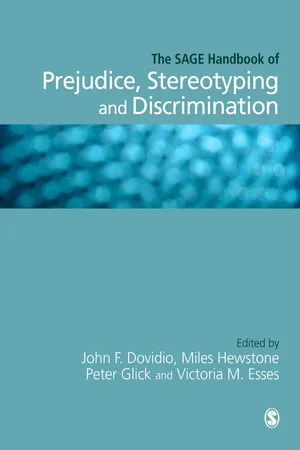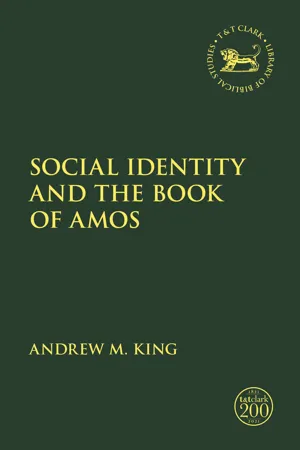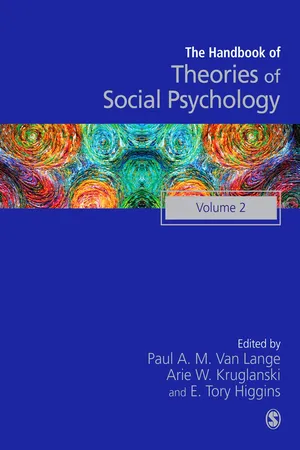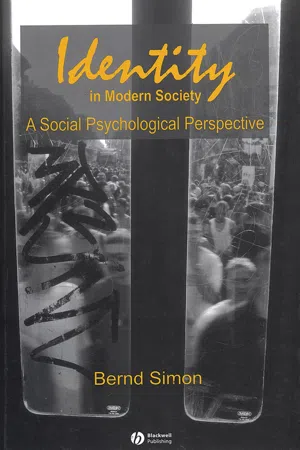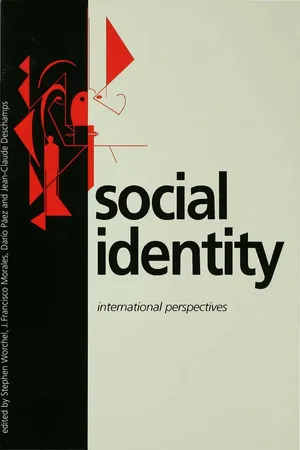Psychology
Social Identity Theory
Social Identity Theory, proposed by Henri Tajfel, suggests that a person's self-concept is based on their membership in social groups. It explains how individuals categorize themselves and others into in-groups and out-groups, leading to social comparison and the formation of stereotypes. The theory emphasizes the role of social context in shaping an individual's identity and behavior.
Written by Perlego with AI-assistance
Related key terms
1 of 5
12 Key excerpts on "Social Identity Theory"
- eBook - ePub
Contemporary Social Psychological Theories
Second Edition
- Peter J. Burke(Author)
- 2018(Publication Date)
- Stanford University Press(Publisher)
5 Social Identity Theory Michael A. Hogg INTRODUCTIONSocial Identity Theory is a social psychological analysis of the role of self-conception in group membership, group processes, and intergroup relations. It embraces a number of interrelated concepts and subtheories that focus on social-cognitive, motivational, social-interactive, and macrosocial facets of group life. The theory, which can be considered a midrange theory, is explicitly framed by a conviction that collective phenomena cannot be adequately explained in terms of isolated individual processes or interpersonal interaction alone and that social psychology should place larger-scale social phenomena near the top of its scientific agenda.Social Identity Theory defines group cognitively—in terms of people’s self-conception as group members. A group exists psychologically if three or more people construe and evaluate themselves in terms of shared attributes that distinguish them collectively from other people. Social Identity Theory addresses phenomena such as prejudice, discrimination, ethnocentrism, stereotyping, intergroup conflict, conformity, normative behavior, group polarization, crowd behavior, organizational behavior, leadership, deviance, and group cohesiveness.Social Identity Theory was first developed at the start of the 1970s in Britain by Henri Tajfel, out of his scientific and personal interests in social perception, social categorization, and social comparison and prejudice, discrimination, and intergroup conflict. Over the past forty-five years Social Identity Theory has attracted many collaborators and followers. It has developed and matured conceptually and has motivated, and continues to motivate, a prodigious quantity of research. Although initially a European analysis of intergroup relations, since the early 1990s it has become fully accepted around the world as one of mainstream social psychology’s most significant general theories of the relationship between self and group. However, this popularity has sometimes brought with it a disjunction between some readings of social identity concepts and the concepts themselves. - John F Dovidio, Miles Hewstone, Peter Glick, Victoria M Esses, John F Dovidio, Miles Hewstone, Peter Glick, Victoria M Esses, SAGE Publications Ltd(Authors)
- 2010(Publication Date)
- SAGE Publications Ltd(Publisher)
11 Social Identity and Self-Categorization Dominic Abrams and Michael A. Hogg ABSTRACT Social Identity Theory is one of the most influential and far reaching theories of intergroup relations and group processes. The theory addresses both group and intergroup processes and behavior, embodied in a variety of specific sub-theories, including self-categorization theory. These share a common meta-theoretical framework that links social structure and context with categorization and identity processes. The core process is transformation from categorizing and viewing the self and others as individuals to seeing the self and others in terms of their representativeness of contrasting social groups and categories. We first outline the theoretical background and history of Social Identity Theory. We then describe (a) the nature of the transformation from individual to collective representations; (b) how social identity has been conceptualized more recently, in terms of its motivational implications; and (c) the consequences for biases in intragroup and intergroup behavior. SOCIAL IDENTITY AND SELF-CATEGORIZATION This chapter describes the main features of Social Identity Theory (SIT) – the nature and function of social identity, and the process and effects of categorizing oneself and other people. SIT has become one of social psychology’s most influential theories, providing wide-ranging explanations of group behavior and intergroup relations, and thus of prejudice and discrimination. For example, a Google search (March 12, 2009) on the term ‘Social Identity Theory’ produced 71,100 hits, compared with 36,300 for ‘cognitive dissonance theory,’ and 25,500 for ‘terror management theory’. Between 1997 and 2007, of publications on intergroup relations in social psychology’s top eight journals 36.1 per cent invoked social identity as a key concept (Randsley de Moura, Leader, Pelletier, et al., 2008).- eBook - PDF
- Margaret Wetherell, Chandra Talpade Mohanty, Margaret Wetherell, Chandra Talpade Mohanty, SAGE Publications Ltd(Authors)
- 2010(Publication Date)
- SAGE Publications Ltd(Publisher)
2 The Social Identity Approach in Social Psychology Stephen Reicher, Russell Spears and S. Alexander Haslam In this contribution we review a family of social psychological theories, most notably Social Identity Theory (SIT) and Self-categorization Theory (SCT), which together constitute what we refer to as the Social Identity Approach (SIA). These theories are linked by their concern with the processes that surround the way in which people define themselves as members of a social group – which, here, is the meaning of the term ‘social identity’. At a conceptual level, this approach serves to transform the understand-ing of identity in psychology. It stresses the sociality of the construct in at least three ways. First, social identity is a relational term, defining who we are as a function of our similarities and differences with others. Second, social identity is shared with others and provides a basis for shared social action. Third, the meanings associated with any social identity are products of our collective history and present. Social identity is there-fore something that links us to the social world. It provides the pivot between the individual and society. However, the SIA should not be seen as an exercise in social theory. Within its broad framework, social identity researchers have specified detailed processes that give practi-cal insights into the ways that groups work in society. We will address a number of these including the nature of influence and persua-sion, how leadership works and the nature of group stereotypes. This work has been applied to the behaviour of many different types of groups from electorates, to crowds, to work organizations. Indeed the power of the theory is in direct relationship to its range of application. The very richness of the theory is also a source of danger. Particular postulates can be drawn from the overall framework and devel-oped in ways that ignore or even contradict its foundational premises. - eBook - PDF
Social Identity and Conflict
Structures, Dynamics, and Implications
- K. Korostelina(Author)
- 2007(Publication Date)
- Palgrave Macmillan(Publisher)
The theory of social identity (Tajfel 1978, Tajfel and Turner 1986) stresses that together with personal identity, an individual has a social identity that is reflected in his or her membership in different groups. This identity is an important part of self-conception and influences the individual’s percep- tion of himself or herself and of society as a whole. Social identity is devel- oped through the affiliation of individuals to different groups, along with a determination of their position in society. Individuals perceive themselves as 24 S o c i a l I d e n t i t y a n d C o n f l i c t members of a group and identify themselves with it in order to distinguish between their groups (ingroups) and outgroups. People with similar social positions and common histories have compa- rable social identities. Therefore, social identity is connected not only with the perception of similarities within an ingroup (common history, attitudes, values, etc) but also with the perception of differences between this group and the members of other groups or categories. The more salient social iden- tities are, the more people differentiate their groups from those of others. The theory of social identity stresses the importance of two aspects: cog- nitive and emotional. According to Tajfel and Turner (1986), social identity is “that part of an individual’s self-concept which derives from his knowledge of his membership in a social group (or groups) together with the value and emotional significance attached to that membership” (255). The cognitive basis of social identity is the process of social categorization and intergroup comparison. Therefore, the cognitive component is connected with the emotional one, which reflects such feelings of belonging to a group as love, hate, amity, and enmity. This cognitive-emotional involvement strengthens a person’s social identity. - eBook - ePub
- Joel Harvey, Derval Ambrose, Joel Harvey, Derval Ambrose(Authors)
- 2022(Publication Date)
- Routledge(Publisher)
3 Social Identity Theories Deborah Morris and Elanor WebbDOI: 10.4324/9781315560243-3Introduction
Group membership arises from an evolutionary need to belong, self-protect, survive, and thrive (Over, 2016 ). From our group membership, it is argued that individual self-concept, identity, beliefs, motivations, and behaviour can be understood. The relationship between ‘I’ and ‘we’, and how group membership impacts on self-identity and behaviour, is of long-standing interest to social psychologists (Hogg, 2018 ). Group membership and its relationship to self-concept and offending behaviour is also a core concern for those working with forensic populations.Group membership is broadly defined as a “set of individuals who hold a common social identification or view themselves as members of the same social category”1 (Stets & Burke, 2000 , p. 225). The criterion for social category is broad. It can range from temporary membership based on transient criteria and time-limited activities, through to more enduring, stable, or demographic membership variables. Group membership can also constitute the perception of a collective shared social identity (SI), which, in turn, can facilitate group behaviour (Hogg & Rinella, 2019 ). Social psychological experiments have consistently demonstrated that group membership has far-reaching consequences for self-concept, and for relationships and behaviour between and within groups across settings, including healthcare (Bochatay et al., 2019 ). While different theories have been developed to account for group behaviour and its relationship with self-concept, SI approaches remain the dominant ‘meta-theory’ (Hogg & Vaughn, 2018 ).Social Identity Theories
From their inception, SI theories have been concerned with attempting to account for the extreme behaviours of individuals enacted in the context of group membership. As such, they are well positioned to account for behaviours that fall outside of social norms, including offending in the context of mental disorder. They are rooted in post-World War II political dogma that attempted to understand Nazism and the psychosocial processes that made acts, such as genocide possible. In this context, initial models that focused on individual factors, such as the Authoritarian Personality (Adorno et al., 1950 ), were developed. They promoted the belief that behaviour in the Nazi regime was the manifestation of individual [personality] dysfunction- a belief that was consistent with post-war formulations that emphasised the ‘Germans are different’ hypothesis. Sherif’s (1966) - eBook - PDF
The New Psychology of Health
Unlocking the Social Cure
- Catherine Haslam, Jolanda Jetten, Tegan Cruwys, Genevieve Dingle, S. Alexander Haslam(Authors)
- 2018(Publication Date)
- Routledge(Publisher)
Primarily, then, it is a theory of intergroup relations. It is clear, however, that there is a broader set of questions that relate to the functioning of social and personal identity and social groups more generally. When do we define ourselves in terms of social identity? What determines which particular social identity defines our sense of self in any given context? What are the conse- quences of defining the self in terms of a particular social identity? The depersonalisation process It was to answer such questions that Turner and his colleagues developed self-categorization the- ory in the 1980s and 1990s. At the outset a core goal of the theory was to explain what it was, psycho- logically, that allowed people to engage in group behaviour. Traditional answers to this question had pointed to the importance of interdependence and mutual attraction, but Turner found these unsatis- factory. For a start, this was because these elements were absent in the minimal group paradigm, and yet this produced clear evidence of group behaviour (in the form of ingroup favouritism). Other work, dating back to a series of famous studies conducted in boys camps in the United States by Muzafer Sherif and his colleagues (see Sherif, 1956; Platow & Hunter, 2017), also showed that when it comes to predicting people’s behaviour in intergroup contexts, personal liking and friendship are often trumped by a sense of shared (or non-shared) group membership. As we have seen, Turner thus argued that it was social identity that provided the psychological platform for group behaviour. Beyond this, he also argued that group behaviour arose from the process of defining oneself in terms of social identity – a process he termed depersonalisation. - eBook - PDF
- Andrew M. King(Author)
- 2021(Publication Date)
- T&T Clark(Publisher)
Chapter 2 T he S ocial I dentity A pproach “Identity” is a fundamental concept for human beings. 1 This much is clear from the wide range of fields that invoke identity. From religion and politics to gender and race, identity forms a central concept around which a sense of self may be situated. 2 Yet amidst the discussion of identity there can often be an assumed or underdeveloped theoretical framework employed. What exactly do we mean by “identity”? What does it mean to identify with a particular group? Moreover, how does this identification affect one’s behavior? This chapter discusses important issues related to identity, leading to the specific framework of social identity employed throughout this work. Social Identity Historically, there have been numerous approaches to identity. For example, in sociological studies, the concept generally relates to the roles a person plays in the social world. Erving Goffman, a twentieth-century sociologist, likened people’s social roles to actors on a stage, living out a public or group identity. 3 Other sociological perspectives, such as symbolic interactionism, examine how a person’s identity is affected by 1 . For a survey and history of identity studies, see Margaret S. Wetherell, “The Field of Identity Studies,” in The Sage Handbook of Identities , ed. M. S. Wetherell and C. T. Mohanty (London: Sage, 2010), 3–26. Also see R. Jenkins, Social Identity . 2 . A survey of the entries in the Encyclopedia of Identity shows the diversity of usage. See Ronald L. Jackson, ed., Encyclopedia of Identity , 2 vols. (Thousand Oaks, CA: Sage, 2010). 3 . Erving Goffman, The Presentation of Self in Everyday Life , Anchor Books ed. (Garden City, NY: Doubleday, 1959). Also see David Shulman, The Presentation of Self in Contemporary Social Life (Thousand Oaks, CA: Sage, 2017). 2. The Social Identity Approach 9 social structures. 4 In psychology, Erik Erikson’s psychosocial develop-mental analysis is the best-known treatment of identity. - eBook - PDF
- Paul A M Van Lange, Arie W Kruglanski, E Tory Higgins, Paul A M Van Lange, Arie W Kruglanski, E Tory Higgins, Author(Authors)
- 2011(Publication Date)
- SAGE Publications Ltd(Publisher)
In explaining how individuals come to define themselves in terms of one social identity rather than another, SCT thus emphasizes the importance of a range of contextual contexts that elements contexts that serve to make one particular social self-categorization more meaningful than others. The principles it articulates also predict that the same objec-tive group membership will be experienced differently, depending on the groups with which an ingroup is compared and the situa-tion in which these comparisons are made (Haslam and Turner, 1992). Importantly too, SCT introduced the con-cept of depersonalization , to describe the psychological process through which people come to perceive the self as an interchange-able exemplar of a social category, rather than as a separate individual with unique traits (i.e., so that the self is defined in terms of social identity rather than personal Social Identity Theory 389 identity; Turner, 1982). Moreover, the theory also specifies the behavioral consequences of depersonalization, arguing that it is this proc-ess that makes group behavior possible. In particular, Turner (1982) hypothesized, and early studies confirmed, that depersonaliza-tion is a basis for group cohesion, interper-sonal attraction, and social cooperation (e.g., Hogg, 1992; Hogg and Turner, 1985). Later work also elaborated upon the implica-tions of self-categorization and depersonali-zation for processes of stereotyping (Oakes and Turner, 1990; Oakes et al., 1994), social influence (Turner, 1991), and leadership (Turner and Haslam, 2001). More recently still, research has shown that self-categoriza-tion processes play a key role in the expres-sion of personal identity (Turner and Onorato, 1999; Turner et al., 2006). - eBook - PDF
Identity in Modern Society
A Social Psychological Perspective
- Bernd Simon(Author)
- 2008(Publication Date)
- Wiley-Blackwell(Publisher)
As a reaction, there have been various suggestions for further theoretical elaboration of SIT and refinement of its key concepts, but controversies still persist (for overviews, see Brown, 2000; Turner & Reynolds, 2001). I suspect that the continuing controversies are due at least in part to an insufficient appreciation of the limited focus of SIT. It was deliberately developed with a focus on social identity which involves only ‘limited aspects of the self’ and is ‘relevant to certain limited aspects of social behaviour’ (Tajfel, 1978a, p. 63). That is, SIT is primarily a theory of the consequences of social identity for intergroup conflict and harmony. It is not, and was probably never intended to be, a general theory of self or identity which systematically analyses and compares the different variants of identity (e.g. social vs. personal identity) and their specific antecedents and consequences. In recognition of these inherent limitations, self-categorization theory was developed as a more comprehensive theoretical framework for the analysis of identity to which I will now turn. Self-categorization theory (SCT) The distinction between personal identity and social identity (Turner, 1982) marks the beginning of SCT which was then elaborated in greater detail by Turner et al. (1987). Personal identity means self-definition as a unique individual in terms of interpersonal or intragroup differentiations, whereas social identity means self-definition as a group member in terms of ingroup–outgroup differentiations. As this broader basis indicates and the following discussion will further illustrate, SCT is a more general theoretical framework than SIT. SCT specifies the antecedents and consequences of personal and social identity and can thus provide explanations for both (inter-)individual and (inter)group behaviour as well as an explanation for the transition from one form of behaviour to the other. - eBook - PDF
Social Identity
International Perspectives
- Stephen Worchel, J Francisco Morales, Darío Páez, Jean-Claude Deschamps, Stephen Worchel, J Francisco Morales, Darío Páez, Jean-Claude Deschamps(Authors)
- 1998(Publication Date)
- SAGE Publications Ltd(Publisher)
PART I REPRESENTATIONS OF SELF AND GROUP 1 Regarding the Relationship Between Social Identity and Personal Identity lean-C laude Deschamps and Thierry Devos The problems to be discussed in this chapter can be considered the central issue regarding both identity and a general perspective of social psychology; the theme of this chapter describes the relationsh ip between two concepts called social identity and personal identity. Few concepts are as polysemic as ident ity. The idea of identity appears in the first texts of Antiquity (the famous 'Know Thyself' of Delphi) and is used in both everyday language and scholarly discourses; it is also the concern of many scient ific disc iplines. There are many synonyms or near synonyms for identity (one can mention at random: oneself, t, the self, we, self-perception, self-image, self-representation or self-awareness, the ego, and so on). The self can refer to a famil iar subject, but also to a social agent's action. It can also refer to active processes and mechanisms that rule behaviour. Therefore, our remarks are limited to specific aspects of identity. Social identity and personal identity Identity is a central concept in social psychology, probably because it is one of the main concerns of that field. As Codol wrote (1979, p. 424), that major concern -which has been the subject of very old debates regarding philosophy and relig ion as well as ideology and the humanities -simply refers to the conflict of affirmation and ind ividual necessity versus affir-mation and collective necessity, the search for personal identity versus the search for collective identity, what constitutes ind ividual difference versus what constitutes sim ilar ity to others (same things constitute both), social 2 Social identity: international perspectives visibil ity versus conformity, in short the conflict of the individual versus the group. - eBook - ePub
The New Psychology of Health
Unlocking the Social Cure
- Catherine Haslam, Jolanda Jetten, Tegan Cruwys, Genevieve Dingle, S. Alexander Haslam(Authors)
- 2018(Publication Date)
- Routledge(Publisher)
Chapter 1 . In particular, this is because they challenge the dominant model of the self that prevails in psychology (and in Western society as a whole) which sees the true nature of the person as residing in their immutable individuality, and hence which sees pathways to health as largely requiring engagement with, and mobilisation of, this individuality and an associated sense of personal identity.The alternative view that we have set out does not question the importance of individuality or personal identity for our sense of personhood or for our behaviour. However, it suggests that this is most likely to have an impact on health and well-being where it emerges out of, rather than independently of, meaningful group memberships (Greenaway et al., 2015; Jetten et al., 2015). Indeed, more generally, we suggest that people’s internalised group memberships – that is, their social identities – can be an essential source of psychological robustness and resilience. In large part this is because, as we have seen, social identities constitute key psychological resources of the form summarised in Figure 2.8 . Moreover, as well as being psychological, these resources have important material consequences for the groups they are members of and for the social world that those groups are part of.This can be seen clearly in each of the three examples with which we started this chapter. In Sardinia, the residents of the mountain villages are observed to have a fierce and proud sense of their shared and distinctive identity (Pinker, 2015); at the Magh Mela pilgrims revel in the opportunity to live out their shared religious faith (Tewari et al., 2012); in outback Australia resilient farmers report feeling a strong sense of belonging with others in their community that helps them to cope with the adversity of drought and hardship (McLaren & Challis, 2009; McPhedran & De Leo, 2013b; Schirmer, Mylek, Peel, & Yabsley, 2015). In all these cases it is not simply personal resilience or hardiness that protects health; rather this seems to flow from depersonalised connections between people that are a source of support, solidarity, and strength. - eBook - PDF
Identity Process Theory
Identity, Social Action and Social Change
- Rusi Jaspal, Glynis M. Breakwell(Authors)
- 2014(Publication Date)
- Cambridge University Press(Publisher)
This appears to mark a crucial point of difference between the two approaches that merits closer inspection. In addressing these contrasting perspectives on the distinction between personal and social identity, let us consider some background to Tajfel’s notion of social identity in early accounts of SIT. Many readers will be familiar with the following routinely quoted definition of social identity given by Tajfel (1978): “For the purpose of this discussion, social iden- tity will be understood as that part of an individual’s self-concept which derives from his [sic] knowledge of his membership of a social group (or groups) together with the value and emotional significance attached to that membership” (p. 63). Less often quoted, however, are the sentences that immediately follow: “It will be clear that this is a limited definition of ‘identity’ or ‘social identity.’ This limitation is deliberate and it has two aims. The first is not to enter into endless and often sterile discussions as to what ‘is’ identity. The second is to enable us to use this limited concept in the discussions of theory and research which follow” (p. 63). Thus, it is clear that Tajfel had no interest here in developing a com- prehensive theory of “identity” per se. Rather, as he went on to explain, his concern was specifically with understanding intergroup behavior and social change. He was interested in identity insofar as it was instrumental to that goal. Tajfel’s most fundamental contention in this work was that, in order to understand intergroup phenomena such as conflict, stereo- typing and prejudice, one needs a theoretical perspective that not does assume people to be “randomly interacting individual particles” (Tajfel, 1972, p. 16) and that instead recognizes that they can act on the basis of A social identity perspective on IPT 99 understanding themselves as group members.
Index pages curate the most relevant extracts from our library of academic textbooks. They’ve been created using an in-house natural language model (NLM), each adding context and meaning to key research topics.

